Labs and Facilities
Our labs offer students and faculty multiple opportunities to conduct experiments and provide hands-on experience with real life applications.
Explore Our Labs
Mechanical Engineering Labs
Heat Transfer Laboratory – Anderson 142
This laboratory provides hands-on experience with key modes of heat transfer, including conduction, convection, radiation, boiling and condensation. Students utilize modern instrumentation and perform thermal experiments to analyze heat exchangers and validate theoretical principles in practical applications.
The heat transfer lab offers students hands-on experience in exploring various heat transfer mechanisms, such as conduction, convection and radiation, as well as practical applications through heat exchanger analysis.
The lab is equipped with advanced and diverse instrumentation, including data acquisition systems, thermocouples and thermal imaging tools; students perform real-time measurements and analyze thermal performance under various conditions.
Through problem-solving sessions and guided experiments, students learn to
correlate theoretical concepts with real-world engineering challenges. Emphasis is placed on experimental data, data interpretation and application of industrial scenarios such as heating, cooling, steady state analysis and thermal management.
The lab builds essential skills in:
- Thermal system analysis
- Experimental-based analysis
- Team-based technical and operational communication
They proved as an essential element to bridge the gap between the theoretical concepts taught in the classrooms and real-life engineering practices, preparing the students for research, innovation and design in thermal sciences.
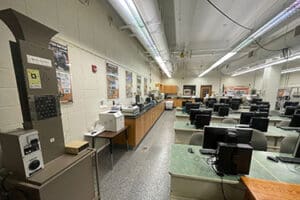

Materials Heat Treatment Laboratory – Anderson 144
Students in this lab explore how heat treatment affects the physical and mechanical properties of materials. Through hands-on use of furnaces and thermal processing equipment, they examine microstructural transformations and understand the link between processing methods and material performance.
In this lab, students explore how thermal processing techniques alter the structure and properties of metallic materials. Equipped with heat-treating furnaces, students perform processes such as annealing, quenching and tempering. Post-treatment analysis includes evaluating changes in hardness, ductility and microstructure.
Key Learning Outcomes:
- Execution of heat treatment processes
- Understanding structure-property relationships
- Analysis of mechanical property changes post-treatment
Through hands-on experiments, students explore the direct impact of thermal processes on material behavior. This lab bridges theoretical concepts with practical skills, providing essential knowledge for roles in manufacturing, metallurgy and mechanical design.

Materials Polishing Laboratory – Anderson 146
This lab introduces students to the critical process of sample preparation for metallographic analysis. Using precision polishing equipment and abrasive techniques, students learn how to create surfaces that help to reveal the internal structure of metals and alloys under microscopic examination.
The Materials Polishing Laboratory is dedicated to the fundamental process of metallographic sample preparation. Students acquire practical experience utilizing polishing wheels, abrasive papers and refined alumina pastes to generate smooth, imperceptible surfaces.
These polished samples are fundamental for microscopic examination, enabling the visualization of grain boundaries, inclusions and other structural characteristics. The laboratory emphasizes precision, consistency and the significance of surface quality in material analysis.
Key Learning Outcomes:
- Sample preparation for optical and SEM imaging
- Comprehension of polishing techniques and abrasives
- Development of consistency in surface finish for microstructural analysis
Students actively engage in cultivating critical sample preparation skills that serve as the foundation for precise material evaluation. The laboratory cultivates attention to detail and technical discipline, which are essential for successful work in materials characterization and failure analysis.

Engineering Microscopy Laboratory – Anderson 147
Focused on advanced material analysis, this lab offers training in both optical and scanning electron microscopy (SEM). Students gain valuable experience in visualizing surface features, analyzing microstructures and identifying elemental composition through energy-dispersive spectroscopy (EDS).
This laboratory offers students comprehensive exposure to advanced imaging technologies for material analysis. It is equipped with both optical microscopes and a scanning electron microscope (SEM), facilitating the visualization of microstructural features at diverse magnifications. The inclusion of energy-dispersive spectroscopy (EDS) enables elemental analysis and mapping. Students utilize this laboratory to investigate fracture surfaces, material defects and the intricate relationships between microstructure and properties.
Key Learning Outcomes:
- Operations of optical and scanning electron microscopes
- Elemental analysis utilizing EDS
- Microstructural evaluation and defect identification
Through this laboratory, students gain direct experience in visualizing and interpreting material microstructures and compositions. This practical experience enhances their understanding of the correlation between microstructure and material behavior, equipping them for careers in materials science, quality control and advanced research.
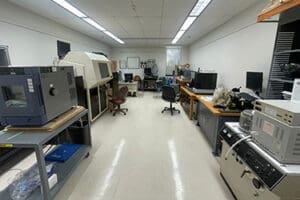
Mechanical & Civil Engineering Characterization Laboratory – Anderson 149
Explore how materials perform under real-world loading conditions. This lab gives students hands-on experience with tensile, creep and impact testing, providing critical insights into material strength and deformation behavior. The lab prepares students to assess structural integrity and make informed engineering decisions.
This lab is designed for comprehensive mechanical and material testing. Students conduct experiments using tensile, creep, hardness and impact test machines to understand the deformation and strength characteristics of various materials.
Key Learning Outcomes:
- Tensile, creep, hardness and impact testing techniques
- Structural integrity assessment and failure detection
Through a variety of experimental tests, students acquire the ability to evaluate and predict material performance. The laboratory enhances experimental skills and reinforces the safety and quality assurance principles prevalent in engineering industries.
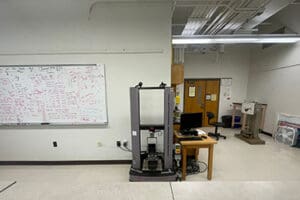

Mechanical & Civil Engineering Multidisciplinary Laboratory – Anderson 150
A diverse experimental space supporting both civil and mechanical engineering projects. Students engage with equipment such as a concrete compression unit, universal vibration apparatus, anaerobic digester and gyratory compactor to study structures, materials and environmental systems.
This multipurpose laboratory supports a wide range of projects across mechanical and civil engineering disciplines. Equipment includes a concrete compression machine, gyratory compactor, universal vibration apparatus and an anaerobic digester. Students engage in interdisciplinary experimentation involving infrastructure, materials and energy systems.
Students engage in experiments that explore infrastructure, materials, and energy systems. These experiments provide hands-on experience and allow students to apply their knowledge in practical settings.
Key Learning Outcomes:
- Concrete strength testing
- Pavement material compaction
- Mechanical vibration analysis
- Bioenergy system studies
Students gain exposure to multi-domain equipment and real-world challenges, fostering problem-solving and teamwork skills. The laboratory encourages integrated learning, supporting innovation in infrastructure, sustainability and mechanical systems.
Fluid Mechanics Laboratory – Anderson 152
The Fluid Mechanics Lab enables students to explore fundamental fluid behavior through experiments focused on viscosity, Reynolds number, flow regimes and pressure loss. Using classical measurement tools and flow systems, students gain a deeper understanding of theoretical concepts through direct observation and analysis.
The Fluid Mechanics Laboratory offers students a hands-on learning experience that directly supports the core concepts taught in lecture. This lab focuses on the physical principles that govern fluid behavior, such as Reynolds number, viscosity, pressure loss and flow regimes, providing students the opportunity to see fluid mechanics in action.
Students perform experiments that explore:
- Laminar vs. turbulent flow transitions
- Measurement of fluid viscosity
- Head loss in pipe systems
- Applications of Bernoulli’s
Using classic laboratory equipment such as Reynolds apparatus, viscometers, manometers and Venturi meters, students gain practical skills in data collection, analysis and interpretation — all while reinforcing their theoretical understanding.
This lab bridges the gap between theory and real-world engineering applications by helping students:
- Visualize flow behavior under different conditions
- Understand the impact of fluid properties on system design
- Build a solid foundation for more advanced fluid dynamics and thermal-fluid systems
The Fluid Mechanics Lab prepares students for careers in fields such as mechanical, civil and chemical engineering by providing the essential knowledge and lab experience needed to analyze and design fluid-based systems.
Fatigue and Fracture Research Laboratory – Anderson 164
Designed for advanced study of material failure, this lab includes rotating beam and MTS fatigue machines for testing under real-world loading conditions. Students explore fatigue behavior, wear analysis and fracture mechanics using environmental chambers and high-precision optical tools.
This specialized laboratory is dedicated to the study of material fatigue and fracture behavior under diverse loading and environmental conditions. Students utilize rotating beam machines and a hydraulically operated MTS fatigue machine equipped with an environmental chamber to conduct realistic testing. The laboratory’s equipment includes a cross-cylinder wear tester and optical systems for crack analysis.
Key Learning Outcomes:
- Fatigue testing under cyclic loading
- Wear and crack propagation analysis
- Realistic environmental fatigue simulations
Students apply theoretical knowledge to understand and analyze material degradation under repeated stress. The laboratory enables a comprehensive understanding of failure mechanisms, equipping students for roles in safety-critical design, testing and reliability engineering.
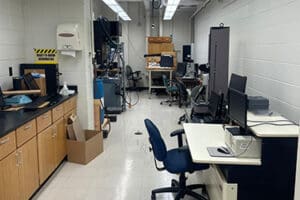
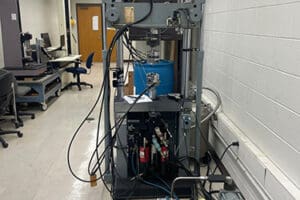
Finite Element Analysis & Digital Manufacturing Laboratory – Anderson 245
This lab features 20 individual workstations dedicated to training in finite element analysis (FEA), computer numerical control (CNC) programming, computer-aided design (CAD) and rapid prototyping. Students also explore fracture mechanics, fatigue life estimation and validate simulation data using results from physical testing labs.
This lab equips the students with practical skills in modern engineering design and analysis. Featuring 20 computing stations, the lab supports hands-on learning, including finite element analysis (FEA) and Computer Numerical Control (CNC) programming, which are critical to machine design and manufacturing workflows.
Students gain hands-on experience working along:
- FEA software to simulate stress, strain and thermal behavior of components.
- G-code and H-code programming to operate CNC machines, simulating tool paths and machining operations.
In addition to digital design, the lab bridges computational modeling with physical testing. Students test and model real-world failure modes such as fracture mechanics, crack propagation, fatigue life estimation and compare the simulation results with experimental data.
The integrated approach enables students to:
- Predict failure mechanisms in structural components.
- Validate FEA models against experimental results.
- Prepare for careers in mechanical design, product design, product development and advanced manufacturing.
The lab provides technical experience as well as engineering intuition, preparing students for real-world applications in the field of engineering.
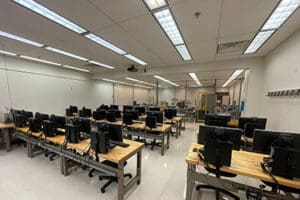
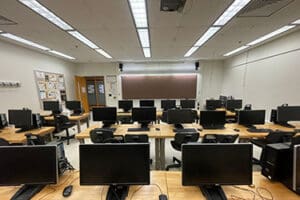
Manufacturing & Robotics Laboratory – Anderson 245
This lab trains students in modern manufacturing processes, including industrial robotics, CNC programming and automated systems. It features robotic arms, conveyor cells, vision systems, rapid prototyping and coordinate measuring machines for a comprehensive smart manufacturing experience.
This laboratory provides students with an immersive experience in the principles of modern manufacturing and automation. It includes an industrial robot, educational robotic arms, CNC equipment, a fully integrated manufacturing cell with conveyor belts, a vision system and cutting machines. Students also gain experience with a rapid prototyping machine and a coordinate measuring machine (CMM).
Key Learning Outcomes:
- CNC programming and toolpath simulation
- Robotics and vision system integration
- Rapid prototyping and part inspection
- Smart manufacturing systems and automation
Students perform real-world tasks in automation, quality control and advanced manufacturing. The lab promotes technical competency and creativity, enabling students to excel in modern, technology-driven production environments.
Mechanical Engineering Experimentation Laboratory – Anderson 246
This laboratory focuses on precision measurement and structural testing techniques. Students work with tools such as micrometers, sine bars, gage blocks and conduct experiments involving torsion, combined bending and torsion, pressure calibration, and dynamic response analysis of mechanical systems.
The Mechanical Engineering Experimentation Lab offers students a structured and hands-on environment to explore the principles of mechanical behavior and precision measurement.
Students begin by working with precision instruments such as gage blocks, micrometers, vernier calipers, adjustable parallels and sine bars—tools critical for mastering dimensional measurement and geometric tolerancing.
The laboratory extends beyond measurement into dynamic and structural behavior. Students conduct experiments involving torsion of circular shafts, combined bending and torsion and beam vibration studies, allowing them to observe material deformation and dynamic response firsthand.
Additionally, the lab includes pressure calibration using a dead-weight tester and transient temperature analysis using thermometers with known time constants.
Key Learning Outcomes:
- Perform accurate linear and angular measurements using precision instruments
- Conduct torsion and bending tests to evaluate material strength and stiffness
- Analyze the dynamic behavior of beams and mechanical components
- Calibrate pressure devices using dead-weight testing techniques
- Interpret time-dependent thermal response and link it to system dynamics
- Apply error analysis and data interpretation to improve experimental accuracy
The Mechanical Engineering Experimentation Laboratory provides students with the practical skills and engineering intuition necessary to become effective problem solvers. By working with both classic and advanced measurement tools, students gain a deep appreciation for accuracy, repeatability and the value of physical testing in validating engineering solutions.
This lab strengthens their ability to design, test and refine mechanical systems—skills that are essential whether they enter design, manufacturing, research or quality assurance roles.
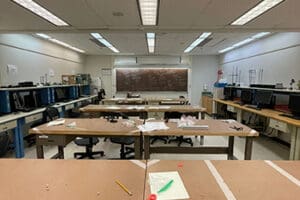

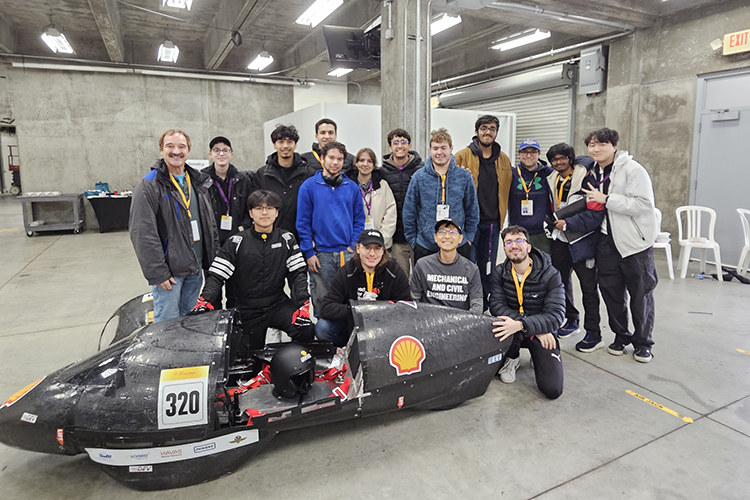
Civil Engineering Labs
Hydrology & Hydraulics Laboratory – Anderson 142 & 152
Explore flow channels, weirs and flood modeling tools. Use HEC-RAS and GIS software to evaluate real hydrologic and hydraulic systems in engineering applications.
The Hydrology & Hydraulics Laboratory is designed to introduce students about basics of open channel flow and pipe flow basics. The lab integrates physical equipment with digital modeling tools, allowing students to observe, measure and simulate how water behaves in rivers, channels and urban infrastructure.
Students use a 10-foot flow channel with various weirs and spillways to explore energy losses, flow patterns, finding coefficient of discharge for weirs, finding Manning’s of channel bed. They also use pipe friction apparatus and conduct experiment for finding friction factor. Students also participate in developing simulation models using HEC HMS and HEC RAS models.
On the software side, students utilize:
- HEC-HMC for watershed and rainfall-runoff modeling
- MEC-RAS for simulating river hydraulics and floodplain mapping
- ArcGIS for spatial visualization and analysis
Key Equipment and Capabilities:
- 10-foot open-channel flow system with interchangeable weirs (v-notch, sharp-crested, broad-crested)
- Spillways and energy dissipaters for hydraulic jump studies
- Pipe Friction apparatus
- Bubble-type flow meter with sonde for water quality testing (DO, pH, turbidity, temperature)
- Current meter and GPS unit for floodplain surveys
- Software: HEC-RAS, HEC-HMS, ArcGIS
Key Learning Outcomes:
- Analyze steady and unsteady open-channel flow characteristics
- Simulate hydrologic and hydraulic systems using professional software
- Apply data interpretation skills to floodplain management and water resource planning
- Pipe culvert design using experiential learning
This lab provides a dynamic platform for students to understand both the physical and simulation models regarding water flow and management.
By connecting field-based experiments with advanced modeling tools, students are prepared to contribute to the design, evaluation and maintenance of modern water infrastructure. The skills gained are highly relevant for careers in civil engineering, environmental consulting, water resource planning and municipal services.
Concrete Laboratory – Anderson 150
Mix, test and analyze concrete using real construction materials. Learn how workability, strength and durability come together in structural engineering.
The Concrete Laboratory equips students with the skills to design, mix, test and evaluate concrete used in construction. It is part of the civil engineering materials lab. Students learn the importance of material proportions, mixing techniques and curing conditions. The lab includes hands-on use of slump cones, mixing machines, curing tanks and compression testers, preparing students for quality assurance roles in civil engineering.
Key Learning Outcomes:
- Prepare concrete mix designs and conduct slump tests
- Test concrete specimens for compressive strength
- Understand the influence of admixtures and cement types
- Analyze how curing and handling affect concrete performance
In this lab, students move from theory to practice by creating and testing one of the most widely used materials in civil engineering—concrete. They not only learn how material choices and curing conditions affect strength and durability, but also how to troubleshoot mix designs and implement industry standards.
This hands-on exposure ensures students understand the full lifecycle of concrete, from mixing to failure testing. As a result, they are better prepared to contribute to construction quality assurance, structural design and materials innovation in the field.
GIS Laboratory – Anderson 159
Work with industry-grade equipment to evaluate critical soil properties. From sieve analysis to Proctor compaction and shear tests, this lab connects soil behavior to foundation safety.
The GIS Laboratory introduces students to Geographic Information Systems and their applications in civil and environmental engineering. Students learn how to collect, manage, analyze and present spatial data using ArcGIS software. This lab bridges the gap between field data and digital mapping, giving students the ability to visualize patterns and relationships within geographic data.
Key Learning Outcomes:
- Use ArcGIS software for mapping and spatial data analysis.
- Understand GIS applications in engineering and planning.
- Overlay field-collected data on digital maps for interpretation.
- Perform basic spatial analysis for design and assessment.
The GIS Lab empowers students to move beyond paper-based design and embrace data-driven spatial decision-making. By mastering ArcGIS and related tools, students gain the ability to manage large datasets, conduct spatial analysis and visually communicate complex geographic relationships.
These capabilities are increasingly in demand across fields like urban planning, transportation, water resources and environmental engineering. The lab prepares students to think critically, interpret spatial trends and design more informed and resilient infrastructure systems.
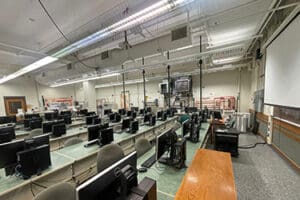
Soil Engineering Laboratory – Anderson 159
Work with industry-grade equipment to evaluate critical soil properties. From sieve analysis to Proctor compaction and shear tests, this lab connects soil behavior to foundation safety.
In the Soil Engineering Laboratory, students perform a wide range of tests to evaluate the physical and mechanical behavior of soils. Using industry-standard equipment, they analyze properties such as grain size, compaction, shear strength, moisture content and permeability. These tests are critical for designing safe foundations and understanding soil-structure interactions.
Key Learning Outcomes:
- Conduct soil classification and Atterberg limits tests
- Perform Proctor compaction and direct shear tests.
- Evaluate unconfined and confined compressive strength of soils.
- Interpret test results to support geotechnical engineering decisions.
This laboratory provides students with a foundational understanding of how soil behaves under different loads and environmental conditions—insight that is critical to every aspect of civil construction.
By working with a broad range of testing equipment, students learn to validate theoretical models, interpret data accurately and translate lab findings into practical foundation and earthwork design decisions. The lab fosters a strong connection between classroom geotechnical concepts and their real-world implications in safety, design and long-term performance of structures.
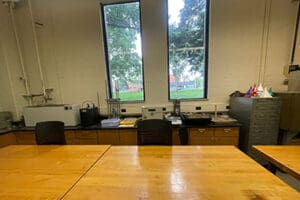
Surveying Laboratory – Anderson 246
Gain hands-on experience with dumpy levels, total stations and GPS systems. Learn how to conduct field-survey experiments and analyze terrain data just like professionals in the field.
The Surveying Laboratory provides students with practical experience in land surveying and measurement techniques. The laboratory is equipped with a comprehensive suite of instruments commonly utilized by professionals in the field, including level instruments, total stations, theodolites, measuring tapes and GPS devices. Students work in teams to perform real-world survey operations and record data essential to civil engineering projects.
Key Learning Outcomes:
- Understand and apply fundamental surveying techniques.
- Operate equipment such as total stations and GPS systems.
- Collect, interpret, and plot field survey data.
- Gain experience in topographic and construction site surveys.
Through real-world surveying exercises, students gain more than just familiarity with technical equipment—they develop spatial awareness, team coordination and field data interpretation skills that are essential for site planning and construction management.
By conducting surveys using industry-standard tools, students bridge classroom theory with the realities of civil engineering practice. This lab builds the confidence and competence necessary for students to succeed in roles involving site layout, infrastructure planning and geospatial documentation.
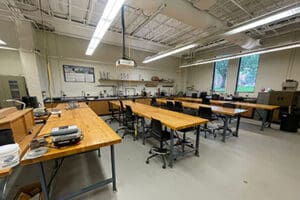
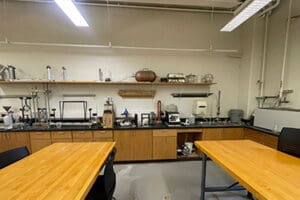
Mechanics of Materials Laboratory – Anderson 246
Offers students hands-on experience in determining structural properties (Poisson’s ratio and shear modulus) and measuring structural stress (Bending normal and principal) and stress concentration factors.
The Mechanics of Materials Lab offers students hands-on experience in various areas:
- Measuring structural dimensions and angles
- Determining structural properties: Poisson’s ratio and shear modulus
- Measuring structural stress (Bending normal and principal) and stress concentration factors
- Conducting virtual experiments to analyze structural stress and stress concentration factors
- Measuring the natural frequency of structures
Detailed list of equipment for each experiment:
Measurement of structural dimensions and angles
- Equipment: Gage blocks, angular blocks, adjustable parallels, bubble levels, sine bars, calipers, micrometers, dial gages and protractor.
Measurement of structural properties: Poisson’s ratio and Shear modulus
- Equipment: Cantilever beams with strain gages, data acquisition systems, weights and a shaft torsion system (with angle indicator)
Measurement of structural stress (Bending normal and principal) and stress concentration factors
- Equipment: Cantilever beams with strain gages, data acquisition systems, weights, and a shaft torsion system (with angle indicator)
Virtual experiments of structural stress and stress concentration factor
- Equipment: Desktop computers with ANSYS software
Measurement of the natural frequency of a structure
- Equipment: A Free and Forced Vibrations Module, which includes the motor-base setup, the HVT12k data acquisition unit, the HAC110 speed controller and a ruler.